Electric heating in a private house: an overview of the best types of electric heating systems
The choice of a heating system is a key issue, the solution of which determines the comfort of living and the safety of the owner’s financial resources. Considering the various options, it is worth paying attention to electric heating in a private house, evaluate its pros and cons, to compare with other offers.
Modern systems powered by electricity are very diverse. Not all of them consume an excessively large amount of electricity. We will consider each of them in detail.
The content of the article:
Why choose electric heating?
It is generally accepted that heating a house with systems powered by electricity is too expensive. Therefore, their advantages are somehow not taken into account.
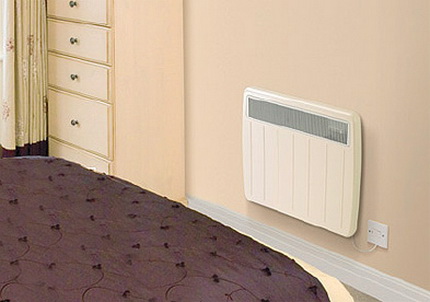
This is fundamentally wrong, because electrical systems have many significant advantages that distinguish them from other types of heating:
- Safety. The equipment does not work with an open flame and explosive substances, like other heating appliances. Qualitatively laid wiring - reliable protection against possible fire.
- Easy to manage and maintain. Automatic systems regulate the operation of equipment, which requires minimal human intervention. Items requiring regular replacement or cleaning are missing.
- Complete environmental safety. During operation, the system does not emit toxic substances, so it can be mounted in any room.
- No need to store fuel. Therefore, a special room for storing combustible materials is not required.
- Compactness. Most of the equipment is small in size. A diverse design of devices makes it easy to choose a model for anyone according to the style of the interior.
- Low cost. Compared to other types of heating appliances, the price of such equipment is much lower.
Of the significant shortcomings of electrical systems, in addition to the fairly high cost of electricity, in fairness, it should be noted the complete energy dependence of the equipment.
This means that when the power is cut off, all devices will stop working, which will be especially noticeable in areas with frequent blackouts. In addition, for the smooth operation of the equipment you will need a powerful electrical network, which is not everywhere.
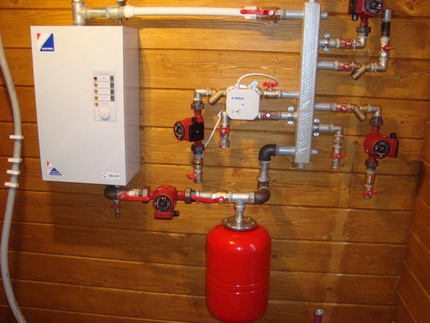
Water heating with electric boiler
It is a standard system with a liquid coolant circulating in the heating circuit. Its main difference is that the heat carrier is heated only through the use of an electric boiler.
By virtue of this, such a system will have some features. First of all, it can only be closed and must be equipped membrane expansion tank.
Otherwise, it will not be possible to avoid uneven heating of the premises, loss of speed and heat transfer capacity, which will lead to an excessive consumption of electricity and, accordingly, unjustified costs. For the same reasons, it is not recommended to install a system with natural circulation.
The best option is the forced circulation of the coolant, which will make it possible to save energy as much as possible. To work with such a heating system, three types of electric boilers can be used. We will analyze the advantages and disadvantages of each of them.
Boilers with heaters type TEN
In each of these devices, heating elements are installed. These are heating elements operating on the principle of resistive heating of a conductor through which an electric current passes.
Due to the fact that they have to work in liquids, protection is additionally installed on the devices in the form of a waterproof case and reliable insulation. Therefore, the power of the heating elements decreases slightly.

As a result, the efficiency of each such heater is no more than 80. Therefore, in order for boilers of this type to heat the coolant to the desired temperature, it is necessary either to increase the number TENOVor put heaters of greater power.
In any case, energy losses are inevitable, which negatively affects the efficiency of devices of this type. Most often, manufacturers install 3-4 heating elements in one boiler. Different modes of operation of the device are provided. Depending on this, all heating elements can be included in the work, only one of them or a group of elements.
Power electric boilers TENOVO type varies from 3 to 50 kW. The most powerful models are designed to be connected to a three-phase network, while the less powerful models can operate from a single-phase network.
The layout of the heating elements in the device may be different, which affects their appearance. They can be made in the form of cylinders with heating elements “hidden” inside and a control unit removed into a separate housing or have a familiar rectangular shape with controls displayed on the housing.
The cost of boilers of this type is very low, due to their inefficiency.
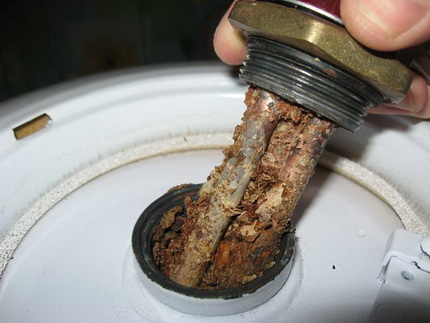
TEN devices also have disadvantages. First of all, this is a short period of "life" of the heating element. During operation of the device, it is covered with salt deposits and fails.
Therefore regular change of heating elements such a device is necessary. Another “minus” is that when starting up equipment with a small amount of coolant or in its absence, the heaters fail.
Electrode boilers
The principle of operation of the device is fundamentally different from the heating elements. To obtain heat, frequency oscillations in a variable network are used, which, in turn, cause vibrations of ions in the electrolyte, which leads to its rapid heating.
The boiler itself is a housing with two electrodes immersed in a coolant, the role of which is a conductive liquid or electrolyte. Most often, antifreeze of one or another brand is used for these purposes.
Electrode devices favorably differ in compactness and light weight, while their heating power is high. Such boilers can be installed in groups, putting into operation one or several devices at once as necessary. Another advantage of the electrode equipment is its almost complete insensitivity to voltage drops in the network.
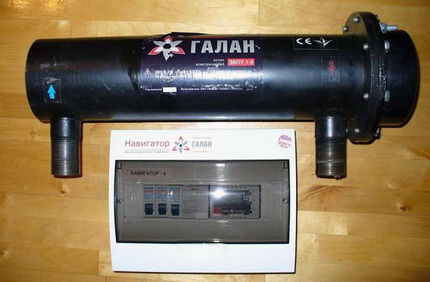
The difference range safe for them is 15-20%, which is quite a lot. However, for devices, the stability of the AC frequency is very important. Electrode boilers are completely fireproof, since such a device cannot overheat, and in the absence of a coolant it simply will not turn on.
The device heats up very quickly. In terms of efficiency, it is 20% higher than the TEN analog, that is, its efficiency is about 98%. At the same time, its performance can be increased.
This is achieved by tying the device with metal pipes. Thus, the ionization zone of the coolant is significantly expanded, which gives the effect of increasing productivity. The cost of electrode boilers is low. Therefore, when such equipment only appeared, it was considered almost the ideal heating device.
However, during the operation, shortcomings were revealed. First of all, this is not the stable power of the device.
It very much depends on the chemical composition of the conductive fluid and its temperature, since even with small deviations the conductivity of the solution changes, which leads to changes in the intensity of heating. In addition, the electrode system is very difficult to automatically control and adjust.
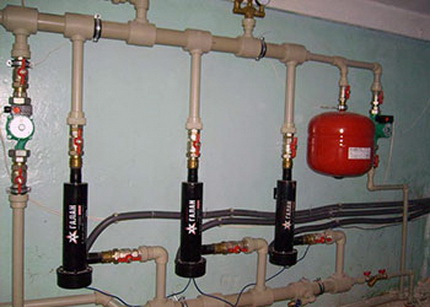
For boilers of this type, composition is extremely important. coolant. If the proportions of the solution or its contamination are not observed, all the advantages of such a system disappear. Therefore, at least once a year, it is required to carry out the correction of the chemical composition of the electrolyte.
With the same frequency, it will be necessary to clean the heat exchanger and the entire heating system from salt deposits, which will accumulate quickly enough. A prerequisite for connecting the electric heating system of the electrode-type house is the presence of a grounding circuit.
Thus, despite the fact that such heating devices are more economical than their heating elements, they are not particularly in demand. A sufficiently large number of disadvantages make their use for heating a private house is not entirely convenient.
Induction heating boilers
These are the most perfect representatives of electric heating systems. The basis of these devices is the principle of electromagnetic induction. Everything happens as follows. An electric current is passed through the primary winding located in the core of the device.
It induces voltage in the secondary winding, located closer to the housing of the device. It is a labyrinth pipe system through which the coolant passes.

When the secondary circuit is closed, a resistive heating of the conductor, and, accordingly, the coolant, occurs. There are no energy losses, so the efficiency of such a system is almost 100%.
Liquid heating occurs very quickly and evenly. Induction boilers are very economical. This indicator increases even more due to the self-induction of the system, which is associated with additional reactive power.
It is generated by currents passing through a secondary closed loop. In this case, the values of the resulting additional power are quite large. A slightly different kind of induction boiler acts - a vortex induction heater or VIN.
A voltage is applied to its primary winding, which is previously converted to high-frequency. Thus, the intensity of the electromagnetic field increases sharply.
What gives the same rapid increase in the current generated by this field? The peculiarity of the VIN boiler is that it does not have a secondary winding. Instead, all the metal surfaces of the equipment are used.
They are specially made from materials with pronounced ferromagnetic properties. The appearance of eddy currents leads to magnetization reversal, which causes a strong and almost instantaneous heating of ferromagnetic alloys.
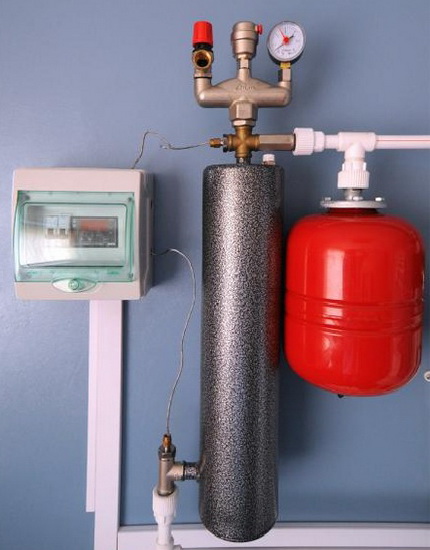
Therefore, almost all massive elements of the casing are involved in the heat exchange process, which makes it possible to obtain a very high efficiency approaching 100%. Induction boilers of both varieties are significant in weight and relatively small in size. They can be installed one at a time or in groups, the latter provides significant advantages in organizing the heating of a building.
An induction type boiler for arranging a summer house or a small private house can be done by yourself. Induction Boiler Assembly Guide, given in the article recommended by us, will help you choose the best option and competently build the unit.
The advantages of induction boilers include fast, almost instantaneous heating. The equipment is easily adjustable, therefore, automatic control units are mounted on it, providing accurate settings. In terms of electrical and fire safety, these devices are most prosperous when compared with other types of analogues.
The high efficiency of induction devices does not decrease even after prolonged use. This is due to the fact that salt deposits or scale do not accumulate inside the device. They are removed by high-frequency microvibrations that accompany the operation of the equipment.For the same reason, there are no special requirements for the chemical composition of the coolant. Boilers are insensitive to it.
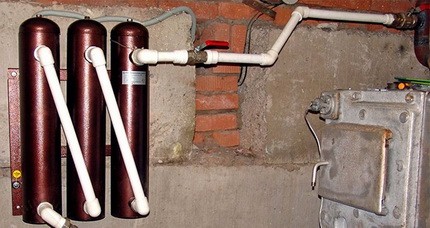
Another advantage is the long life of induction boilers. Without exaggeration, it can be tens of years old. This is due to the fact that equipment with simply does not have vulnerable nodes. The contact of the electrical part of the device with the coolant is completely absent.
Problems can only occur with welds, which usually last a very long time. The main advantage of this type of equipment is its economy.
Practice shows that it allows you to save up to 40% of electricity compared to its heating elements and electrode counterparts. Of the shortcomings, it is worth noting the small vibrational noise that the boilers make during operation.
Massiveness, which requires attention during installation, especially if the device is fixed to the wall. Another disadvantage is the rather high cost of induction devices.
Equipment for infrared heating
To heat your country house with electricity, you can use modern infrared heating systems. For their work, the principle of wave energy transfer to a certain distance is applied.
Everything happens as follows. The emitter converts electrical energy into an infrared wave and transmits it. The waves move until they reach any opaque surface.
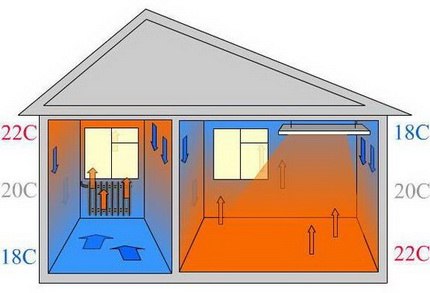
Here they are converted into thermal energy, heating the body that met in their path. An object heated in this way, be it large furniture, floor or wall, begins to transfer heat to the atmosphere, thereby heating the air in the room.
Thus, the room is heated as uniformly as possible, with temperatures being distributed in the most comfortable way for humans. At the same time, there is practically no energy loss, which leads to a high efficiency of infrared heaters.
They are available in various versions. Especially popular is the special infrared film with carbon emitters sealed inside. It is used to equip a system of underfloor heating, can be used on the ceiling and walls. The film is closed with any finishing material, which does not affect its properties.
The thickness of the infrared film is small, it is invisible under any coating. The system is moisture resistant, it is not afraid of dynamic loads. To be dismantled and reused.
On sale can be found infrared heaters, there are both ordinary and made in the form of plates of various sizes. They are also designed to be mounted on walls or ceilings. True, in this case we are talking more about additional heating than about the main one.
In terms of efficiency, infrared equipment surpasses all known electric heating systems. This is due to the fact that he manages to very quickly heat the room, after which the automatic control unit periodically turns the device on / off, maintaining the desired temperature regime.
The disadvantages of infrared systems include the strict focus of heating. The device heats only the area located in front of it. Therefore, for example, an infrared film is laid around the entire perimeter of the floor or ceiling.
Another disadvantage is the rather high cost of such equipment, especially if you need to purchase material for arranging a warm floor or PLEN system for the ceiling. However, it must be admitted that such investment quickly pays off.

Heating electric convectors
The operation of these appliances is similar to the functioning of heating radiators. They also heat up and transfer heat to the surrounding air. The difference is that there is no coolant in the convectors. Therefore, inlet / outlet pipe systems are not needed.
Instead, there are heating elements inside the device that heat its surface. The bottom of the device is designed to draw in cold air.
It penetrates the convector through a special mesh. Heated by the heater, the air rises higher and exits through the upper grill.
In the process of operation of the heater, a steady upward flow of warm air is created, which quickly heats the room. To control the heating temperature, the equipment is equipped with a thermostat, an automatic control unit can be installed.
Manufacturers produce a wide range of devices of various capacities and designs. For rooms with high humidity, devices with special protection can be purchased. Introduces the selection criteria for an electric convector next articlewhich we advise you to read.
Convectors are extremely easy to operate and safe.The heating element of the device is located inside its body, while the external panel heats up very little, so it is impossible to burn yourself.
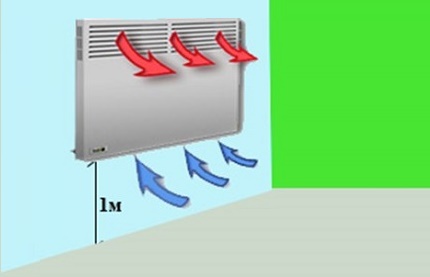
Heating appliances are silent, therefore they do not create any inconvenience. Various variations of convectors are produced, among which there are mobile portable models. There are devices for floor mounting. They are installed under windows, in front of doors and in other similar places where the devices create an effective thermal curtain that prevents the ingress of cold into the room.
The negative characteristics of convectors include their low power. Therefore, to heat the building will require a sufficiently large number of them, which is a serious load on the wiring. In addition, the efficiency of such devices is low. They consume a fairly large amount of electricity.
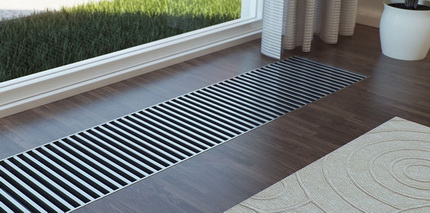
Electric systems "heat-insulated floor"
Their principle of operation is the use of resistive conductors, which heat up when an electric current passes through them. In fact, electric underfloor heating represents a heating cable, which can be two or single-core, which determines the method of its installation.
There are varieties equipped with a semiconductor matrix. These are the so-called self-regulating cables that can control heating.
To equip a warm floor, a heating cable can be taken, which is laid directly in the screed. There is no other installation option for it. In this case, the cement screed becomes a kind of heat accumulator.
A more convenient option for styling is electric mats. They represent the same heating cable, which is fixed to a fiberglass mesh.
The advantage of mats is the possibility of laying not only in the screed. In some cases, for example, under ceramic tiles, such a system can be laid directly in the glue, the layer of which will need to be slightly increased.
The main disadvantage of both cable floor options can be considered that if one of the system sections is damaged, the part of the structure located behind it fails.
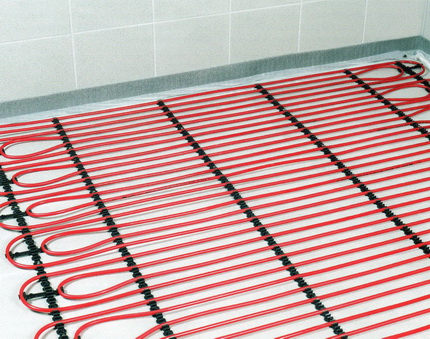
This lack of rod heating mats. They are pairs of conductors connected in parallel by spaced rods.
The system operates on the principle of self-regulation of the degree of heating. Underfloor heating of any type is equipped with a thermostat, which controls the heating of the device to a certain temperature, after which the equipment is turned off.
Periodic automatic switching on of the system is carried out only in order to maintain the set temperature. This mode of operation allows you to save electricity, however, such heating is still quite energy-intensive.
Therefore, it is more often used as an additional heating system and for arranging particularly comfortable warm zones in the rooms. It can be, for example, sites for children's games or the floor in the bathroom.

Varieties of electric heated floors used in everyday life given here. Those wishing to compare different versions of systems, evaluate their pros and cons, we recommend that you familiarize yourself with the contents of this article.
Conclusions and useful video on the topic
A video review will tell which of the electric boilers to choose for your home:
Consider the features of various types of electric underfloor heating:
How does infrared heating work:
Oil radiators, electric heaters, and similar equipment can be classified as yesterday. To organize with their help full heating is almost impossible. In addition, they are very uneconomical, therefore, electricity bills will be just space.
The electric heating systems discussed above are effective and can be used for private homes. It is only important to insulate the building well, otherwise you will have to pay too much for electricity.
And what type of electric heating systems do you use to improve the comfort conditions in your home? Perhaps you know the useful subtleties of the choice and operation of heating electrical equipment? Please write comments, leave a photo on the topic of the article, ask questions in the block below.

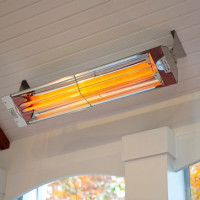 Infrared heating of a private house: an overview of modern infrared heating systems
Infrared heating of a private house: an overview of modern infrared heating systems 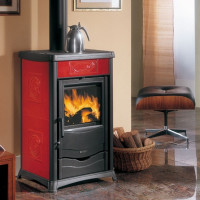 Autonomous gas heating of a private house: device options and an overview of the best solutions
Autonomous gas heating of a private house: device options and an overview of the best solutions  Installation and connection of an expansion tank in open and closed versions of heating systems
Installation and connection of an expansion tank in open and closed versions of heating systems 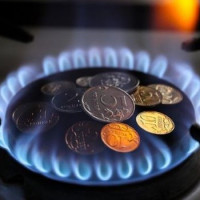 How to save gas when heating a private house: an overview of the best ways to save gas
How to save gas when heating a private house: an overview of the best ways to save gas  Heating from an electric boiler: options for organizing heating based on an electric boiler
Heating from an electric boiler: options for organizing heating based on an electric boiler 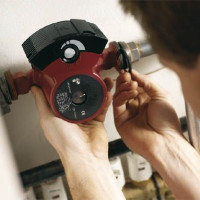 Installing a pump for heating: how to properly install pumping equipment
Installing a pump for heating: how to properly install pumping equipment  How much does it cost to connect gas to a private house: the price of organizing gas supply
How much does it cost to connect gas to a private house: the price of organizing gas supply  The best washing machines with dryer: model rating and customer tips
The best washing machines with dryer: model rating and customer tips  What is the color temperature of light and the nuances of choosing the temperature of the lamps to suit your needs
What is the color temperature of light and the nuances of choosing the temperature of the lamps to suit your needs  Replacement of a geyser in an apartment: replacement paperwork + basic norms and requirements
Replacement of a geyser in an apartment: replacement paperwork + basic norms and requirements
In our cottage, electric heating, in fact, a lot of money is spent on heating the room, so we carefully insulated the house in order to save energy spent on the operation of the boiler and the circulation pump. It's still not cheap, but this method of heating the cottage is much safer, so you have to sacrifice something. I am glad that the costs are not constant, but only in the cold.
For a long time I wanted myself electric heating to the country. Still, I work in the field of ecology, for me it is important. Electrical systems just do not harm the environment, which cannot but rejoice) Moreover, the equipment is considered safe, since it does not work with explosive substances. Here I read more additional information on this topic and realized that you definitely need to install without hesitation.
Warm flooring is the easiest and most practical option, as for me. Near the country house is equipped in this way. The batteries warm the houses, and there, in a wooden house, such a luxury is dumb :) I heard about infrared heating that there is a risk of oncology, I don’t know how true it is, but I was alarmed ... for the video there is a special thanks, very informative.
Gene, with oncology - don't even think about it! Infrared radiation is long waves, longer than visible light. They are emitted, with varying degrees of intensity, by any hot object.
Hello. Infrared radiation is in no way interconnected with the appearance of oncology.Moreover, it is widely used in medicine in physiotherapeutic procedures. Some clinics even practice the treatment of cancer with irradiation.
Good day. In the section about electric heaters, such phrase: “As a result, the efficiency of each such heater is not more than 80”. Very curious - but what happens to the remaining 20 percent? What are they spent on?
Here I have a heater in series with a fuel boiler. "Just in case". By the way, covered with thermal insulation. Power - 4 kW. From the logic of the article, when it is turned on, almost a kilowatt of power is consumed in an unknown direction. Excuse me, where? To swing a spherical horse in a vacuum?